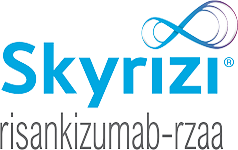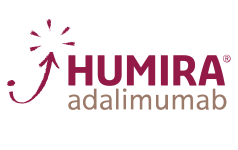A track record of safety across 11 conditions1
Largest safety database in the anti-TNF class2
Evaluated long‑term safety data from HUMIRA global clinical trials, including randomized controlled, open‑label, and long‑term extension studies, assessing serious adverse events (SAEs) of interest. Study was conducted through December 31, 2016.2*
SAEs of interest across 8 adult indications2,†
Rates displayed as events per 100 PYs
| Rheumatoid arthritis (RA) 37,106 PYs N=15,512 |
Ankylosing spondylitis (AS) 2,120 PYs N=2,026 |
Psoriatic arthritis (PsA) 998 PYs N=837 |
Plaque psoriasis (Ps) 5,479 PYs N=3,732 |
Hidradenitis suppurativa (HS) 1,198 PYs N=733 |
Crohn’s disease (CD) 4,359 PYs N=3,896 |
Ulcerative colitis (UC) 3,407 PYs N=1,739 |
Uveitis (UV)a 1,151 PYs N=464 |
||
| Serious infection | 3.9 | 1.8 | 2.8 | 1.8 | 2.8 | 6.9 | 3.5 | 4.1 | |
| Tuberculosis | 0.2 | 0.1 | 0.2 | 0.2 | 0 | 0.2 | <0.1 | 0.4 | |
| Active | 0.2 | 0.1 | 0.2 | 0.2 | 0 | 0.1 | <0.1 | 0.2 | |
| Latent | <0.1 | 0 | 0 | 0 | 0 | <0.1 | 0 | 0.3 | |
| Opportunistic infectionb | <0.1 | 0 | 0 | 0 | 0 | <0.1 | <0.1 | 0.4 | |
| Demyelinating disorder | <0.1 | <0.1 | 0 | 0 | 0 | 0.1 | <0.1 | 0.3 | |
| Lupus‑like syndrome | <0.1 | <0.1 | 0 | 0 | 0 | <0.1 | <0.1 | <0.1 | |
| Congestive heart failure | 0.2 | <0.1 | 0 | 0.1 | 0.2 | 0 | <0.1 | <0.1 | |
| Ps new onset/worsening | <0.1 | <0.1 | 0.1 | <0.1 | <0.1 | <0.1 | <0.1 | 0 | |
| Malignancyc | 0.7 | 0.2 | 0.2 | 0.5 | 0.5 | 0.4 | 0.6 | 0.7 | |
| Lymphoma | 0.1 | <0.1 | 0.2 | <0.1 | <0.1 | <0.1 | <0.1 | <0.1 | |
| NMSC | 0.2 | 0.2 | 0.1 | 0.1 | <0.1 | <0.1 | <0.1 | 0.2 | |
| Melanoma | <0.1 | <0.1 | 0 | 0.2 | 0 | 0 | <0.1 | 0 | |
| Sarcoidosis | <0.1 | <0.1 | 0 | 0 | 0 | 0 | 0 | <0.1 | |
| Any AE leading to death | 0.6 | <0.1 | 0.3 | 0.2 | 0.5 | 0.1 | 0.1 | 0.6 | |
Because clinical trials are conducted under widely varying and controlled conditions, adverse reaction rates observed in clinical trials of a drug cannot be directly compared to rates in the clinical trials of another drug and may not predict the rates observed in a broader patient population in clinical practice.
aNon-infectious (NI) intermediate, posterior, and panuveitis.
bExcludes oral candidiasis and tuberculosis.
cExcludes lymphoma, hepatosplenic T-cell lymphoma, leukemia, NMSC, and melanoma.
*33 in RA, 5 in AS, 3 in PsA, 13 in Ps, 3 in HS, 11 in CD, 4 in UC, and 2 in Non-infectious (NI) intermediate, posterior, or panuveitis.
†Data derived from global clinical trials of HUMIRA, including randomized controlled, open-label, and long-term extension studies (33 in RA, 5 in AS, 3 in PsA, 13 in Ps, 3 in HS, 11 in CD, 4 in UC, and 2 in UV).2
AE=adverse event; NMSC=non-melanoma skin cancer; PYs=patient-years
RISK OF SERIOUS INFECTION1
Patients treated with HUMIRA are at increased risk for developing serious infections that may lead to hospitalization or death. These infections include active tuberculosis (TB), reactivation of latent TB, invasive fungal infections, and bacterial, viral and other infections due to opportunistic pathogens. Most patients who developed these infections were taking concomitant immunosuppressants such as methotrexate or corticosteroids.
Discontinue HUMIRA if a patient develops a serious infection or sepsis.
Test patients for latent TB before HUMIRA use and during therapy. Initiate treatment for latent TB prior to HUMIRA use.
Monitor patients closely for the development of signs and symptoms of infection during and after treatment with HUMIRA, including the possible development of TB in patients who tested negative for latent TB infection prior to initiating therapy.
RISK OF MALIGNANCY1
Lymphoma and other malignancies, some fatal, have been reported in children and adolescent patients treated with TNF blockers, including HUMIRA.
Postmarketing cases of HSTCL, a rare type of fatal lymphoma, have been reported in patients treated with TNF blockers, including HUMIRA. The majority of these cases were in adolescent and young adult males with inflammatory bowel disease who had received concomitant or prior treatment with azathioprine or 6-mercaptopurine.
More cases were observed among HUMIRA-treated adult patients than in controls. Lymphoma, non-melanoma skin cancer (NMSC), acute and chronic leukemia, and others have been reported. Examine all patients for the presence of NMSC prior to and during treatment.
PATIENTS TREATED WITH HUMIRA MAY BE AT RISK FOR OTHER SERIOUS ADVERSE REACTIONS INCLUDING1:
HYPERSENSITIVITY
Anaphylaxis and angioneurotic edema have been reported. If a serious allergic reaction occurs, stop HUMIRA and begin appropriate therapy.
HEPATITIS B VIRUS REACTIVATION
Risk of reactivation may increase in patients who are chronic carriers. Some cases have been fatal. Monitor hepatitis B virus (HBV) carriers during and after treatment with HUMIRA. If reactivation occurs, stop HUMIRA and begin appropriate therapy.
NEUROLOGIC REACTIONS
Exacerbation or new onset central nervous system or peripheral demyelinating disease may occur, including multiple sclerosis, optic neuritis, and Guillain-Barré syndrome. Exercise caution when considering HUMIRA for patients with these disorders. There is a known association between intermediate uveitis and central demyelinating disorders.
HEMATOLOGIC REACTIONS
Rare reports of pancytopenia, including aplastic anemia, have been reported. Consider stopping HUMIRA in patients with significant hematologic abnormalities.
CONGESTIVE HEART FAILURE
Worsening or new onset congestive heart failure (CHF) may occur. Exercise caution in patients with CHF and monitor them carefully.
AUTOIMMUNITY
Treatment with HUMIRA may result in formation of autoantibodies and, rarely, in development of lupus-like syndrome. Stop HUMIRA if symptoms of a lupus-like syndrome develop.
Serious adverse events (SAEs) of interest for HUMIRA® (adalimumab) from the full Prescribing Information1,a
These rates are from the controlled portions of 39 global HUMIRA trials in adult patients with RA, PsA, AS, CD, UC, Ps, HS, and NI uveitisb (events per 100 patient-years):
| HUMIRA (n=7,973) |
Control (n=4,848) |
|
| Serious infectious AEsc | 4.3 | 2.9 |
| Non-melanoma skin cancer (NMSC) | 0.8 | 0.2 |
| Malignancies (excluding NMSC) | 0.7 | 0.7 |
These rates are from 52 global HUMIRA-controlled and uncontrolled clinical trials in adult patients with RA, PsA, AS, CD, UC, Ps, HS, and NI uveitisb (events per 100 patient-years):
| HUMIRA (n=24,605) |
|
| Tuberculosis | 0.20 |
| Serious opportunistic infections | 0.05 |
| Lymphomad | 0.11 |
aThese data pertain to all adult FDA‑approved indications.
bNon-infectious (NI) intermediate, posterior, or panuveitis
cSerious infections observed included pneumonia, septic arthritis, prosthetic and postsurgical infections, erysipelas, cellulitis, diverticulitis, and pyelonephritis.
dThe observed rate of lymphomas is approximately 0.11/100 PYs in clinical trials of HUMIRA-treated patients. This is approximately 3‑fold higher than expected in the general US population according to the Surveillance, Epidemiology, and End Results database (adjusted for age, gender, and race).
AEs=adverse events; AS=ankylosing spondylitis; CD=Crohn's disease; HS=hidradenitis suppurativa; Ps=plaque psoriasis; PsA=psoriatic arthritis; PYs=patient‑years; RA=rheumatoid arthritis; UC=ulcerative colitis



